Abstract
Professional Learning (PL) can positively impact the quality of educators’ instruction through increasing their knowledge, skills, and beliefs. Both educators’ beliefs in their abilities (self-efficacy) and the relevance of the information (utility value) within PL contribute to the likelihood of classroom application. As such, making sure educators are actively engaged in their courses is crucial. The current study examined educators’ feelings of utility value and self-efficacy to understand how they plan to apply what they’ve learned in Michigan Virtual professional learning courses and to ensure courses are designed to facilitate optimal learning outcomes. 177 education professionals who completed a pedagogy-focused PL course with Michigan Virtual over a 90-day period took a survey about their experiences. Just under half of the participants indicated plans to implement what they’ve learned directly. While beliefs in their abilities varied slightly, responses were generally positive. The most positive responses centered on educators’ abilities to implement alternative strategies, get students to believe they can do well in school, and be reflective practitioners. Most participants believed ‘quite a bit’ in their ability to demonstrate and apply their skills and knowledge. As such, it is pivotal that PL courses continue to engage participants through audio/visual elements, readings, and scenarios that highlight the usefulness of the information while providing opportunities for practice and feedback as this will help engage educators and facilitate positive outcomes.
Introduction
What is Professional Learning?
Professional learning (PL) or professional development (PD) typically focuses on developing teachers’ knowledge, skills, or beliefs (e.g., self-efficacy, or the belief in one’s abilities; Gesel et al., 2021). PL enhances teachers’ knowledge, pedagogical strategies, beliefs, or other characteristics that may relate to the quality of their teaching (Bowman et al., 2022; Gesel et al., 2021). In some instances, PL may also include mandatory compliance courses, aligning with certain state or federal standards (e.g., Bloodborne Pathogens).
Professional Learning Matters: Engagement and Teaching Outcomes
Educators’ engagement in professional learning is pivotal as it has the potential to expand their pedagogy. While research examining the impact of PL on teaching practices and student learning is still emerging, some promising findings exist (e.g., Roth et al., 2019). Indeed, research has suggested PL can positively impact student achievement (Blank & Alas, 2010; Yoon et al., 2007). Interviews with teachers about their experiences revealed that being highly engaged in PL leads to improved outcomes in the classroom. In turn, this classroom success motivates teachers to further engage in growing and expanding their pedagogy (Ji, 2021). As such, the structure of PL must engage educators. For example, students whose teachers participated in practice-focused PL outperformed peers whose teachers participated in content-focused PL on a content knowledge test (Taylor et al., 2017). Overall, there is a close relationship between teachers’ engagement in PL and the impact of PL on teaching outcomes.
So what helps foster teachers’ engagement in professional learning? In her blog, Street Data And Empathy: Revealing What Educators Truly Want From Professional Learning, Michigan Virtual professional learning specialist Anne Perez found that educators wanted asynchronous, expert-driven PL incorporating research-based strategies (Perez, 2023). Educators want choices in how they receive instruction and opportunities to apply the knowledge. Across all career stages, educators agree that PL must be application-based and relevant to their roles (Masuda et al., 2013). Professional learning that allows educators to see how to obtain desired teaching outcomes is crucial (Ji, 2021). Relatedly, highlighting the value or utility of the skills for future situations can foster interest (i.e., utility value; Kale, 2018). Indeed, teachers’ willingness to engage in PL is closely tied to its perceived value or importance (Masuda et al., 2013). For example, Zhang & Liu (2019) noted that teachers’ perceptions of the utility of PL communities predicted their engagement with online PL.
The Role of Utility Value and Self-Efficacy in Professional Learning
Looking at more specific practices, PL positively influenced middle and high school teachers’ classroom technology integration by increasing their perceptions of its utility (Bowman et al., 2022). In other words, when teachers saw perceived value in using technology through exposure during PL, they were more likely to integrate it into their teaching practices. As such, professional learning targeting utility values may be especially effective at increasing specific instructional skills. In addition to increasing teacher’s perceptions of the values of the skills being taught, improving their self-efficacy (i.e., belief in one’s ability) surrounding the skills through practice is important. Increasing teachers’ self-efficacy (particularly through providing practice opportunities) may be an important way to encourage instructors to persist in practicing new or challenging skills (Gesel et al., 2021; Palermo & Thomson, 2018).
Indeed, self-efficacy has been noted to predict pedagogical changes to instruction and assessments used in the classroom (Palmero & Thomson, 2018). For example, teachers with high levels of self-efficacy had more positive attitudes and higher levels of implementation for a new PE curriculum for junior high school students in Greece. These teachers also intended to continue implementing new lesson plans in the future (Gorozidis & Papaioannou, 2011). Teachers’ self-efficacy may be related to student achievement. A study of sustained professional learning to improve students’ science achievement found that teachers’ self-efficacy and the number of PL hours positively predicted fourth and sixth-graders performance on a state-standardized science test (Lumpe et al., 2012). Taken together, self-efficacy seems to be important for fostering and maintaining pedagogical changes.
Finally, increasing teachers’ self-efficacy is important because it has been associated with satisfaction, job retention, lowered feelings of depersonalization and emotional exhaustion, increased feelings of professional accomplishment, and improved student outcomes (as cited in Crawford et al. 2021; Evers et al., 2002). All in all, educators’ expectations (“Can I do this?”) and attitudes (“Is this useful?”) are important pieces of their experiences with PL. The current study aimed to assess educators’ engagement in PL courses offered at Michigan Virtual, focusing specifically on feelings of self-efficacy and utility value after taking pedagogically focused PL courses.
The Current Study
A previous report examined educators’ engagement patterns and course offerings through Michigan Virtual, finding that educators were generally satisfied with their professional learning (PL) courses, which they pursued to meet specific requirements. Audio/visual elements were reported as the most engaging and helpful for learning. This companion piece aims to deepen our understanding of educators’ goals for enrolling in PL courses through Michigan Virtual and how the course content meets their needs. By understanding educators’ feelings of utility value and self-efficacy, we can better understand how they plan to apply what they’ve learned and ensure that courses are designed to facilitate optimal learning outcomes. This is particularly important as the perception of utility value and self-efficacy during professional learning can foster positive outcomes for educators and their students.
The goals of the current study led to the following specific research questions:
- What are educators’ goals when enrolling in a course?
- What do educators hope to achieve or get out of their courses?
- What course design elements (e.g., videos, readings, discussion boards) do educators find most valuable?
- How do educators plan to apply course content to their current roles?
- After completing a course, to what extent do educators believe they can engage in certain pedagogical behaviors?
- After completing a course, to what extent do educators feel they have demonstrated their knowledge and skills and can apply course concepts in their roles?
Methods
Educators who completed pedagogy-focused professional learning courses at Michigan Virtual within a 90-day period (December 26th, 2023 to March 19th, 2024) were contacted via email (n = 3083) to take a brief survey about their experience. The survey was developed based on a literature review of established teacher self-efficacy, utility value measures, and expert input. The survey consisted of 12 questions—11 close-ended and one open-ended. For a list of included courses see Appendix A.
Results
Sample / Data Overview
Excluding those who completed less than 50% of the survey (n = 38, 17.67%) resulted in a total sample size of n = 177. Of the 177 respondents, the two most populous courses were ‘Differentiated Instruction: Maximizing Learning for All’ (n = 25, 14.12%) and ‘Social-Emotional Learning: Introduction to SEL’ (n = 20, 11.30%).
Most educators indicated their primary role was ‘Teacher’ (n = 124, 70.06%), while a smaller proportion of respondents were ‘Other’ (n = 15, 8.47%), ‘School Support Staff’ (n = 10, 5.65%), ‘Administrator’ (n = 8, 4.52%), ‘Educational Coach’ (n = 7, 3.95%), ‘Paraprofessional/Educator Support Staff’ (n = 7, 3.95%), ‘Counselor’ (n = 3, 1.69%), or ‘Specialist’ (n = 3, 1.69%). ‘Other’ responses included childcare providers and assistant professors/teachers. Because educators could skip questions, instances where the total number of responses is less than 177 are noted. See Figure 1 below.
Figure 1. Educators’ Primary Role
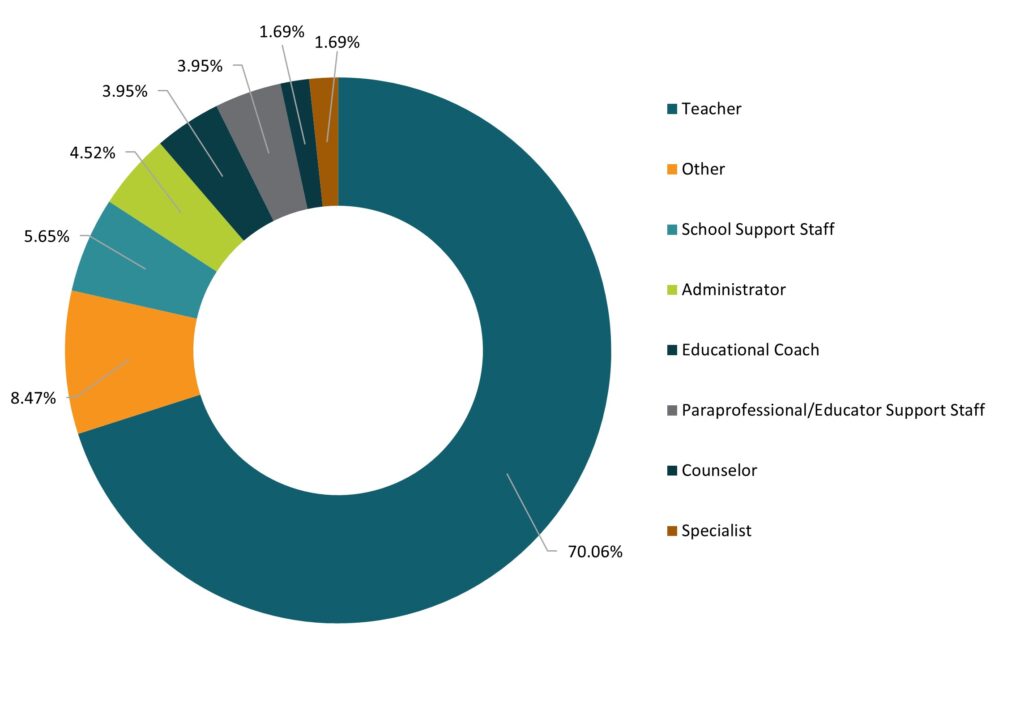
What are educators’ goals when enrolling in a PL course?
Educators’ primary goal when enrolling in PL was obtaining ‘free or inexpensive SCECHs’ (n = 45, 25.42%) closely followed by ‘fulfilling professional development requirements’ (n = 42, 23.73%). Figure 2 below shows all the primary reasons for enrolling in PL courses through Michigan Virtual. In the survey, we also asked about their additional reasons for enrollment.
The most common additional or secondary reason for enrollment was that the course content ‘addresses specific classroom or professional needs’ (n = 64, 37.43%). Among those who did not select it as the primary reason, ‘free or inexpensive SCECH’ (n = 64, 37.43%) was commonly chosen as a secondary reason for enrollment. The total number of responses to this question was 171.
Figure 2. Primary Reason for Enrollment
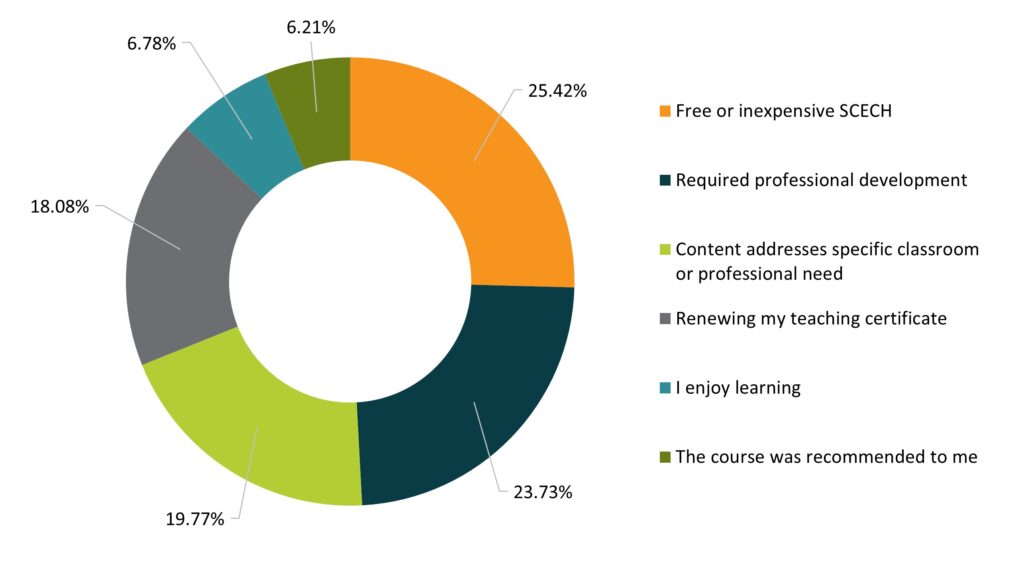
What do educators hope to achieve or get out of their PL courses?
Educators were given a list of goals for their experiences with their professional learning course and asked to select all that applied (see Figure 3 below). Because educators could choose multiple goals, the total number of responses exceeds the number of educators who responded (n = 177). The data presented reflects the number of times that option was selected. ‘Understanding how to teach more effectively’ was chosen 114 times (69.09%) as the most populous goal for respondents’ professional learning experience. Conversely, offering ‘time and space to think’ was selected only 57 times (34.55%) as the least populous goal for engagement in PL.
Figure 3. Goals for Professional Learning Experience
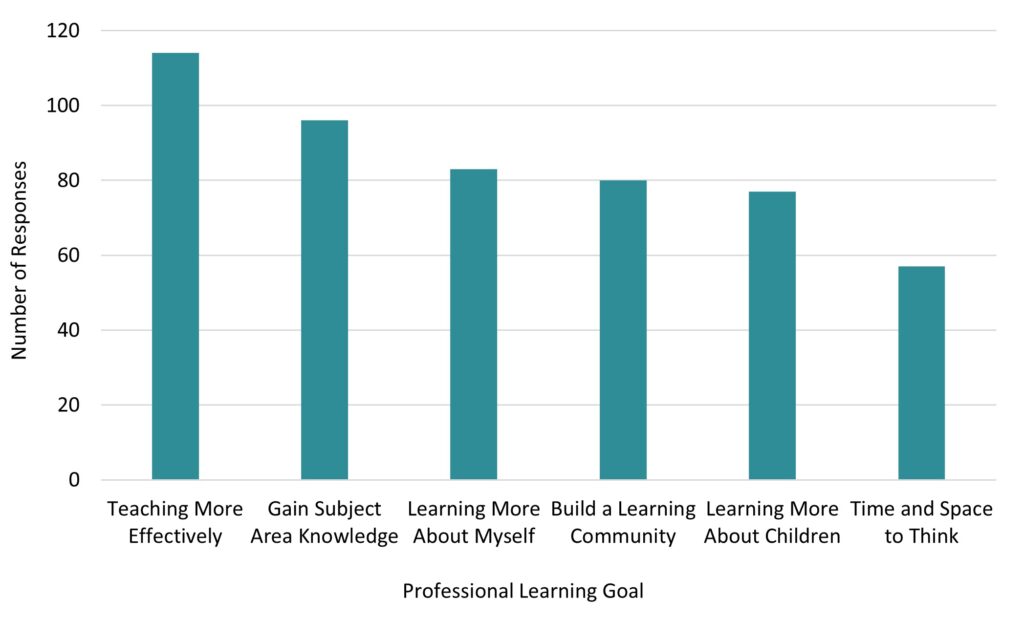
What course design elements (e.g., videos, readings, discussion boards) do educators find most valuable?
Educators were given a pre-defined list of course design elements and asked to choose all options they believed were useful or valuable to their experience in the course (see Figure 4 below). Because educators could choose multiple course design elements, the total number of responses exceeds the number of educators who responded to this question (n = 176). All course elements were selected as being ‘useful or valuable’ at least once, although the frequency with which elements were chosen varied. ‘Video/Audio’ elements were selected most often (n = 123) while ‘Podcasts’ were selected the fewest times (n = 8).
Educators were then asked which of their previously selected course design elements were the most useful or valuable. The top two course design elements educators chose as most useful or valuable were ‘Video/Audio’ (n = 55) and ‘Readings’ (n = 33).
Figure 4. Course Design Elements Indicated as Useful or Valuable in the Course
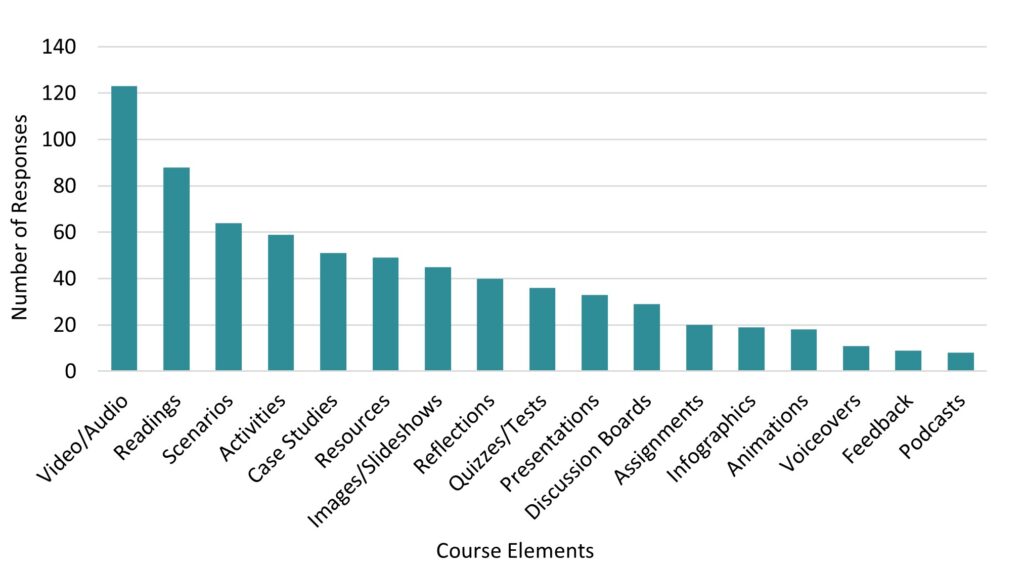
How do educators plan to apply course content to their current roles?
The survey included one open-ended question asking educators how they plan to use the course content in their current roles. After coding their responses, about half (n = 60, 54.05%) of the responses indicated an intention to ‘apply the information and skills directly to their classroom practices and pedagogy.’ Within these responses, educators highlighted how courses helped them move towards student-centered learning practices by focusing on personalization and providing choice and voice. For example, one educator reported the course content will help them include “more variety” when helping students learn concepts and “to differentiate instruction.” Educators also reported moving towards mastery/competency-based approaches:
“Instead of whole group instruction, I have grouped students by ability and offered different ways for students to show mastery.”
The remainder of the responses were split into a few categories shown in Table 1 below.
Table 1. Plan for Applying Course Content
| Theme | n (%) | Example |
|---|---|---|
| Apply Directly to Classroom | 60 (54.05%) | “This course showed me that making the content relevant to the lives of students will allow them to engage.” |
| Relationship-building and Communication Practices | 16 (14.41%) | “To build better relationships with my students.” |
| Build Community or Share PL Learnings | 13 (11.71%) | “Explaining the process to my teachers & showing them how to use that knowledge in the classroom.” |
| Understand/Aware of Social Emotional Needs | 10 (9.01%) | “Help create an effective and safe learning environment for all students.” |
| Reflective Practice | 8 (7.21%) | “I will use what I learned in this course to reflect upon how to approach the second round of assessment in my new and current place of employment.” |
| Teaching Hiatus | 4 (3.60%) | “I am taking a year off and am only now applying for a new position.” |
Just under 15% of responses emphasized applying course content to ‘improve relationship-building and communication with students, guardians, and colleagues’ (n = 16). Intending to ‘share what participants learned’ was also common, as approximately 11.71% of the responses (n = 13) indicated a plan to take what they’ve learned back to their teachers and districts to encourage professional learning and the use of best practices. ‘Understanding the importance of social-emotional health’ was also a common takeaway from course content (n = 10, 9.01%), as highlighted by one educator who noted,
“SEL has a very direct impact on my role with behavior regulation, modification, and support within students. Making a deeper connection with students based on their background and interests will be a core part of my position as an educator.”
A smaller subset of responses (n = 8, 7.21%) noted leveraging course content to become more ‘reflective about their pedagogy.’ A few educators noted that they did not have concrete plans for implementing the knowledge and skills gained from their engagement with PL as they were not currently teaching. These responses were categorized as being on a ‘Teaching Hiatus’ (n = 4, 3.60%).
After completing a PL course, to what extent do educators believe they can engage in certain pedagogical behaviors?
Educators reported their beliefs about their abilities on two sets of pedagogical behaviors: working directly with students (student-focused pedagogy) and being reflective practitioners (teacher-focused pedagogy).
Student-Related Pedagogy Behaviors
After completing their professional learning course, educators were asked about their beliefs in their abilities to engage in several student-focused pedagogy behaviors. Educators were most likely to report being ‘quite a bit’ confident in their ability to ‘motivate students who show low interest in school work’ (35.23%). Regarding beliefs about ‘getting students to believe they can do well in school,’ educators were equally likely to believe ‘a great deal’ and ‘quite a bit’ (32.95%) in their skills. Thirty-two percent of educators believed ‘quite a bit’ in their ability to ‘help students value learning.’ Educators’ beliefs about their abilities to ‘assist families in helping their children do well in school’ were a bit more split; however, 29.14% believed in their abilities ‘quite a bit.’
Educators also generally believed ‘quite a bit’ in their abilities across several assessment-focused pedagogy measures. Thirty-three percent of teachers believed ‘quite a bit’ that they could ‘craft good questions for students,’ and 32.00% believed ‘quite a bit’ in their ability to ‘provide an alternative explanation or example when students are confused.’ Beliefs surrounding ‘using a variety of assessment strategies’ were more spread out, but 29.14% believed in their skills ‘quite a bit.’ Notably, 36.57% of educators believed ‘a great deal’ in their ability to ‘implement alternative strategies in the classroom.’ After completing their respective PL courses, very few participants (~1-6%) did not believe in their abilities ‘at all.’ Figure 5 and Table 2 show the percentage of educators who rated their self-efficacy on various student-focused pedagogy behaviors.
Figure 5. Self-Efficacy for Student-Focused Pedagogy
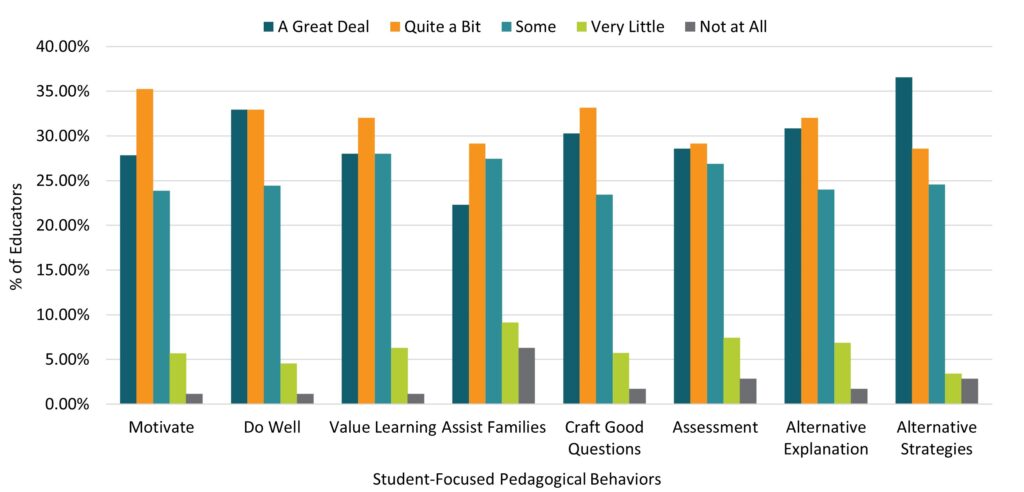
Table 2. Self-Efficacy for Student-Focused Pedagogy
| Behavior | A Great Deal | Quite a Bit | Some | Very Little | Not at All | Total n |
|---|---|---|---|---|---|---|
| Motivate | 27.84% | 35.23% | 23.86% | 5.68% | 1.14% | 176 |
| Do Well | 32.95% | 32.95% | 24.43% | 4.55% | 1.14% | 176 |
| Value Learning | 28.00% | 32.00% | 28.00% | 6.29% | 1.14% | 175 |
| Assist Families | 22.29% | 29.14% | 27.43% | 9.14% | 6.29% | 175 |
| Craft Good Questions | 30.29% | 33.14% | 23.43% | 5.71% | 1.71% | 175 |
| Assessment | 28.57% | 29.14% | 26.86% | 7.43% | 2.86% | 175 |
| Alternative Explanation | 30.86% | 32.00% | 24.00% | 6.86% | 1.71% | 175 |
| Alternative Strategies | 36.57% | 28.57% | 24.57% | 3.43% | 2.86% | 175 |
Teacher Related Pedagogy Behaviors
Educators were asked about their beliefs in their abilities to engage in multiple teacher-related pedagogy behaviors after taking their professional learning course. Overall, educators were ‘a great deal’ confident in their skills post-professional learning. Indeed, 47.59% of educators believed ‘a great deal’ in their ability to ‘reflect on their own classroom strategies and practices,’ while approximately 40% reported ‘a great deal’ of confidence in ‘reflecting on students’ learning and progress.’
Similarly, educators were confident in their ability to be growth-oriented teachers as 44.85% believed ‘a great deal’ in their ability to ‘identify areas for growth and improvement in their teaching practices’ and 36.20% felt ‘a great deal’ confident in their ability to ‘seek out feedback about teaching or instructional approaches.’ Most educators also believed ‘a great deal’ (39.52%) or ‘quite a bit’ (38.92%) in their ability to ‘engage in meaningful professional learning/development.’ Finally, 42.92% of educators reported believing ‘a great deal’ in their ability to ‘consider the importance of understanding students’ cultural backgrounds and experiences.’ Figure 6 and Table 3 show the percentage of educators who rated their self-efficacy on teacher-focused pedagogy behaviors.
Figure 6. Self-Efficacy for Teacher-Focused Pedagogy Behaviors
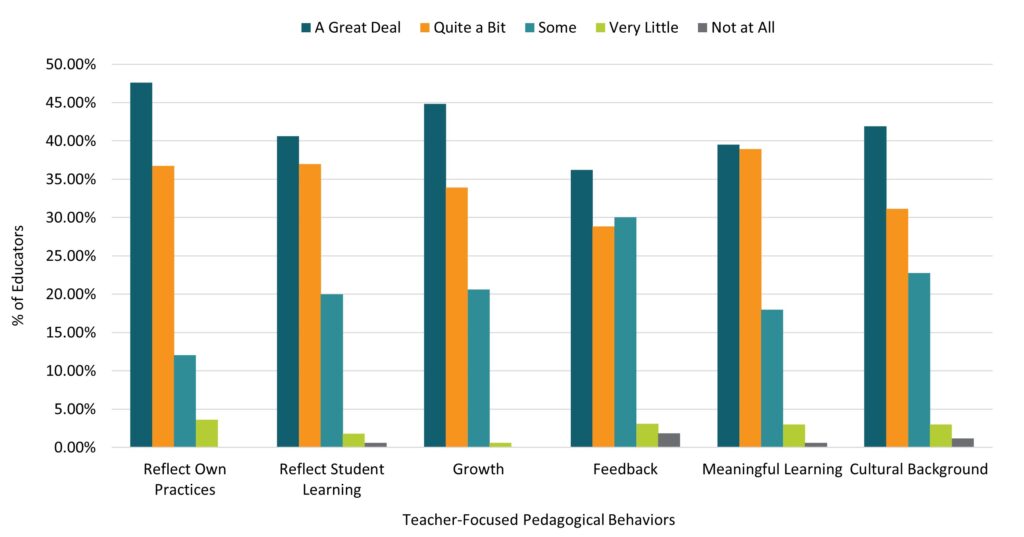
Table 3. Self-Efficacy for Teacher-Focused Pedagogy Behaviors
| Behavior | A Great Deal | Quite a Bit | Some | Very Little | Not at All | Total n |
|---|---|---|---|---|---|---|
| Reflect Own Practices | 47.59% | 36.75% | 12.05% | 3.61% | 0.00% | 166 |
| Reflect Student Learning | 40.61% | 36.97% | 20.00% | 1.82% | 0.61% | 165 |
| Growth | 44.85% | 33.94% | 20.61% | 0.61% | 0.00% | 165 |
| Feedback | 36.20% | 28.83% | 30.06% | 3.07% | 1.84% | 163 |
| Meaningful Learning | 39.52% | 38.92% | 17.96% | 2.99% | 0.60% | 167 |
| Cultural Background | 41.92% | 31.14% | 22.75% | 2.99% | 1.20% | 167 |
After completing a PL course, to what extent do educators feel they have demonstrated their knowledge and skills and can apply course concepts to their roles?
After completing their respective PL courses, most participants believed ‘quite a bit’ in their ability to demonstrate and apply their skills and knowledge. Indeed, over half (56.55%) of educators believed ‘quite a bit’ that their ‘knowledge of the content in this course has been accurately assessed’ and that they ‘grasped the content covered in this course’ (60.35%). Similarly, just over half of educators reported ‘quite a bit’ of confidence in their ability to ‘apply what they’ve learned in this course to their current role’ (55.03%) and ‘incorporate what they’ve learned in this course into lesson plans within the next six months’ (50.60%). Finally, just under half (48.24%) believed ‘a great deal’ in the ‘importance of their role as an educator.’ Very few, if any, participants reported not believing in their ability to use or demonstrate skills and knowledge at all (0-2%). Figure 7 and Table 4 show the percentage of educators who rated the utility value regarding knowledge and skills derived from concepts covered in their course.
Figure 7. Utility Value
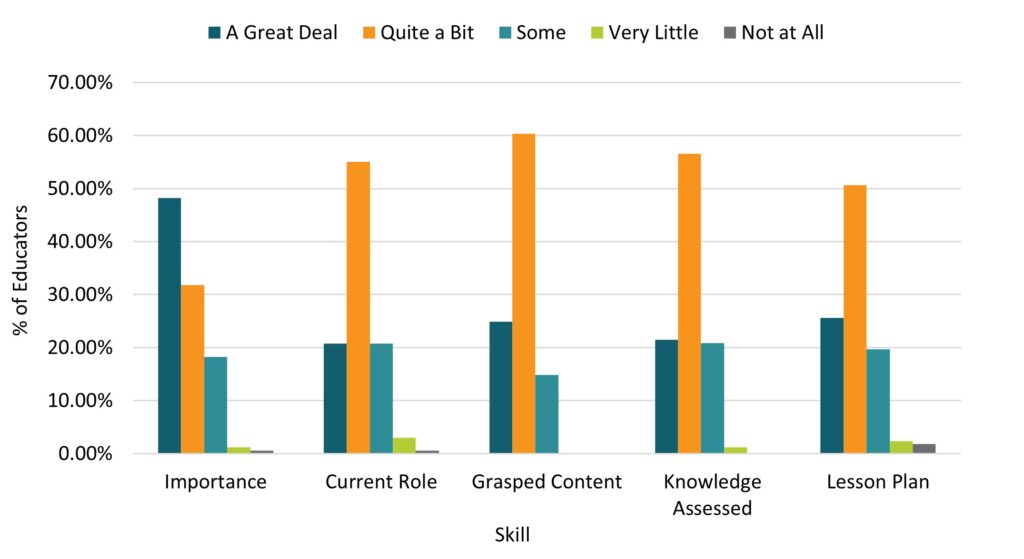
Table 4. Utility Value
| Value | A Great Deal | Quite a Bit | Some | Very Little | Not at All | Total n |
|---|---|---|---|---|---|---|
| Knowledge Assessed | 21.43% | 56.55% | 20.83% | 1.19% | 0.00% | 169 |
| Grasped Content | 24.85% | 60.36% | 14.79% | 0.00% | 0.00% | 169 |
| Current Role | 20.71% | 55.03% | 20.71% | 2.96% | 0.59% | 169 |
| Lesson Plan | 25.60% | 50.60% | 19.64% | 2.38% | 1.79% | 169 |
| Importance | 48.24% | 31.76% | 18.24% | 1.18% | 0.59% | 170 |
Conclusions
Educators indicated their primary goal for enrolling in professional learning courses through Michigan Virtual was to ‘obtain free or inexpensive SCECHs,’ highlighting the importance of providing accessible course offerings. Indeed, a previous analysis indicated that PL courses offered through Michigan Virtual cost about $38.00 on average; however, half of the courses offered cost less than $5.00 (Cuccolo & DeBruler, 2023).
Educators’ secondary goal for enrolling in professional learning courses was to ‘meet professional development requirements.’ The structure of most PL course offerings (online, asynchronous) likely aligns with educators’ preferences, allowing them to meet professional development requirements in a way that works for them and their unique schedules (Perez, 2023).
The most reported goal for engaging in pedagogy-focused professional learning was to ‘teach more effectively’. Given research suggesting that educators benefit the most from practice-focused PL (Taylor et al., 2017), this finding underscores the importance of providing educators a chance to practice skills taught, emphasizing the skill’s usefulness and increasing confidence surrounding skill implementation as these may influence teachers’ use and persistence in the skills and student outcomes (Ji, 2021; Kale, 2018; Masusa et al., 2013; Zhang & Liu, 2019).
The top three most useful and valuable course elements were ‘video/audio,’ ‘readings,’ and ‘scenarios,’ underscoring educators’ desire for engaging content and design elements that provide “real world” or practical examples (Cuccolo & DeBruler, 2023). Scenarios may help educators envision the skills or knowledge in their classrooms or how they may implement what they’re learning in similar contexts. To maximize outcomes, PL courses should continue to draw educators in with engaging design elements, while providing plenty of opportunities to practice.
Just under half of the educators sampled had plans to use the course content ‘directly in their classrooms.’ However, just over 13% didn’t have plans to leverage course content in any way. While a portion of that was due to respondents not currently teaching, it is important to emphasize the utility of content and provide opportunities for practice so that provided information can reach students and colleagues.
Most respondents believed ‘quite a bit’ in their abilities to ‘apply what they’ve learned to their work in the classroom with students.’ While this is a positive finding as self-efficacy has been associated with student achievement and increased job satisfaction (Crawford et al., 2021; Evers et al., 2002; Gorozidis & Papaioannou, 2011; Lumpe et al., 2012; Palmero & Thomson, 2018), we should continue to strive towards increasing educators’ beliefs in their abilities to further the benefits of PL for both students and teachers. After completing their PL courses, educators believed ‘a great deal’ in their abilities to be ‘reflective practitioners.’ PL courses should continue to provide opportunities for and emphasize the importance of reflection.
Like the number of respondents who had plans to apply course concepts in their classrooms directly, 55% of educators reported being ‘quite a bit’ confident in their ability to ‘apply course concepts.’ Because research suggests that self-efficacy (beliefs in abilities) is related to pedagogical changes, there may be an overlap between those who felt confident in applying course concepts and those who planned to do so. This perhaps underscores the importance of increasing educators’ self-efficacy through opportunities for practice and feedback. Most educators did indicate feeling ‘quite a bit’ confident in their understanding of course content.
Importantly, about 48% of educators believed ‘a great deal’ in the ‘importance of their role.’ Previous research has indicated that teachers’ perceptions of the values in teaching (both personally and for society) were associated with unique dimensions of teaching quality such as classroom management and instructional clarity (Ouwehand et al., 2022) thus, continuing to build educators’ perceptions of their value may have important implications for their pedagogy.
References
Bowman, M. A., Vongkulluksn, V.W., Jiang, Z., & Xie, K. (2022). Teachers’ exposure to professional development and the quality of their instructional technology use: The mediating role of teachers’ value and ability beliefs. Journal of Research on Technology in Education, 54(2), 188-204, https://doi.org/10.1080/15391523.2020.1830895
Cuccolo, K., & DeBruler, K. (2023). Evaluating Professional Learning Course Offerings and Educator Engagement. Michigan Virtual. https://michiganvirtual.org/research/publications/evaluating-professional-learning-course-offerings-and-educator-engagement/
Darling-Hammond, L., Hyler, M. E., Gardner, M. (2017). Effective Teacher Professional Development. Palo Alto, CA: Learning Policy Institute. This report can be found online at https://learningpolicyinstitute.org/product/teacher-prof-dev.
Evers, W. J., Brouwers, A., & Tomic, W. (2002). Burnout and self‐efficacy: A study on teachers’ beliefs when implementing an innovative educational system in the Netherlands. British Journal of Educational Psychology, 72(2), 227-243. https://doi.org/10.1348/000709902158865
Gesel, S. A., LeJeune, L. M., Chow, J. C., Sinclair, A. C., & Lemons, C. J. (2021). A meta-analysis of the impact of professional development on teachers’ knowledge, skill, and self-efficacy in data-based decision-making. Journal of Learning Disabilities, 54(4), 269-283. https://doi.org/10.1177/0022219420970196
Gorozidis, G., & Papaioannou, A. (2011). Teachers’ self-efficacy, achievement goals, attitudes and intentions to implement the new Greek physical education curriculum. European Physical Education Review, 17(2), 231-253. https://doi.org/10.1177/1356336X11413654
Kale, U., & Akcaoglu, M. (2018). The role of relevance in future teachers’ utility value and interest toward technology. Educational Technology Research and Development, 66(2), 283-311. https://doi.org/10.1007/s11423-017-9547-9
Lumpe, A., Czerniak, C., Haney, J., & Beltyukova, S. (2012). Beliefs about teaching science: The relationship between elementary teachers’ participation in professional development and student achievement. International Journal of Science Education, 34(2), 153-166. https://doi.org/10.1080/09500693.2010.551222
Masuda, A. M., Ebersole, M. M., & Barrett, D. (2013). A qualitative inquiry: Teachers’ attitudes and willingness to engage in professional development experiences at different career stages. Delta Kappa Gamma Bulletin, 79(2), 6-14.
Ouwehand, K. H., Xu, K. M., Meeuwisse, M., Severiens, S. E., & Wijnia, L. (2022, March). Impact of school population composition, workload, and teachers’ utility values on teaching quality: Insights from the Dutch TALIS-2018 data. In Frontiers in Education, 7, 815795. Frontiers. https://www.frontiersin.org/articles/10.3389/feduc.2022.815795/full
Palermo, C., & Thomson, M. M. (2019). Large-scale assessment as professional development: Teachers’ motivations, ability beliefs, and values. Teacher Development, 23(2), 192-212. https://doi.org/10.1080/13664530.2018.1536612
Perez, A. (2023, July 27). Street Data And Empathy: Revealing What Educators Truly Want From Professional Learning. [Blog]. Michigan Virtual. Retrieved from https://michiganvirtual.org/blog/street-data-and-empathy
Roth, K. J., Wilson, C. D., Taylor, J. A., Stuhlsatz, M. A., & Hvidsten, C. (2019). Comparing the effects of analysis-of-practice and content-based professional development on teacher and student outcomes in science. American Educational Research Journal, 56(4), 1217-1253. https://doi.org/10.3102/0002831218814759
Taylor, J. A., Roth, K., Wilson, C. D., Stuhlsatz, M. A., & Tipton, E. (2017). The effect of an analysis-of-practice, videocase-based, teacher professional development program on elementary students’ science achievement. Journal of Research on Educational Effectiveness, 10(2), 241-271. https://doi.org/10.1080/19345747.2016.1147628
Yoon, K. S., Duncan, T., Lee, S. W.-Y., Scarloss, B., & Shapley, K. (2007). Reviewing the evidence on how teacher professional development affects student achievement (Issues & Answers Report, REL 2007–No. 033). Washington, DC: U.S. Department of Education, Institute of Education Sciences, National Center for Education Evaluation and Regional Assistance, Regional Educational Laboratory Southwest. Retrieved from http://ies.ed.gov/ncee/edlabs
Zhang, S., & Liu, Q. (2019). Investigating the relationships among teachers’ motivational beliefs, motivational regulation, and their learning engagement in online professional learning communities. Computers & Education, 134, 145-155. https://doi.org/10.1016/j.compedu.2019.02.013
Appendix
Appendix A (click to expand)
| Course Names |
| 5D/D+ Classroom Environment & Culture |
| 5D/D+ Student Engagement |
| Changing Minds to Address Poverty – Achievement Mindset |
| Changing Minds to Address Poverty – Engagement Mindset |
| Changing Minds to Address Poverty – Enrichment Mindset |
| Changing Minds to Address Poverty – Mindsets Matter (Introduction) |
| Changing Minds to Address Poverty – Positivity Mindset |
| Changing Minds to Address Poverty – Relational Mindset |
| Changing Minds to Address Poverty in the Classroom – Graduation Mindset |
| Changing Minds to Address Poverty in the Classroom – Rich Classroom Climate Mindset |
| Differentiated Instruction: Maximizing Learning for All |
| Discover Sign Language |
| Educator Evaluation in MI: Measurement of Student Growth |
| Educator Evaluation in MI: Preparing for Formative Review |
| Elementary Career Awareness eResources in MeL |
| Equity in Online Learning for Multilingual Students |
| Essential Instructional Practices in Early Literacy: K-3 Essential 1 |
| Essential Instructional Practices in Early Literacy: K-3 Essential 2 |
| Essential Instructional Practices in Early Literacy: K-3 Essential 3 |
| Essential Instructional Practices in Early Literacy: K-3 Essential 4 |
| Essential Instructional Practices in Early Literacy: K-3 Essential 5 |
| Essential Instructional Practices in Early Literacy: K-3 Essential 6 |
| Essential Instructional Practices in Early Literacy: K-3 Essential 7 |
| Essential Instructional Practices in Early Literacy: K-3 Essential 9 |
| Essential Instructional Practices in Early Literacy: Pre-K Essential 1 |
| Essential Instructional Practices in Early Literacy: Pre-K Essential 2 |
| Essential Instructional Practices in Early Literacy: Pre-K Essential 5 |
| Essential Instructional Practices in Early Literacy: Pre-K Essential 7 |
| Essential Instructional Practices in Early Literacy: Pre-K Essential 9 |
| Essential Instructional Practices in Early Literacy: School-wide and Center-wide Practices |
| Fostering Student Agency Through Positive Relationships |
| Grammar Refresher |
| Grammar Refresher II |
| Inquiry-Based Learning in Secondary Mathematics Education |
| Inquiry-Based Learning in Secondary Science Education |
| Intro to Computer Science for Middle School Educators |
| Intro to Online Course Facilitation: Practical Knowledge |
| Intro to Universal Design for Learning: Action & Expression |
| Introduction to Blended Learning for School Leaders |
| Introduction to Early Childhood Standards of Quality for B-K |
| Introduction to Phenomenal Science |
| Modern Classrooms Project Essentials |
| Online National Standards 2: Course Content & Design |
| Online National Standards 3: Assessment |
| Online Teacher’s Guide: Announcements |
| OTL Level 1 – Course Content |
| OTL Level 1 – Discussion Boards |
| OTL Level 1 – Grading and Feedback |
| OTL Level 1 – Supporting Exceptional Students |
| Rethinking Classroom Practices with ChatGPT |
| Social-Emotional Learning: Adult SEL and Self-Care |
| Social-Emotional Learning: Creating a Professional Culture Based on SEL |
| Social-Emotional Learning: Embedding SEL Schoolwide |
| Social-Emotional Learning: Equity Elaborations |
| Social-Emotional Learning: Integrating SEL within MTSS |
| Social-Emotional Learning: Introduction to SEL |
| Social-Emotional Learning: Trauma-Informed Support |
| Teaching Preschool: A Year of Inspiring Lessons |
| The Creative Classroom |
| TRAILS Social and Emotional Learning (SEL) Curriculum |
| Whole Child & Continuous Improvement: A Deeper Understanding (MI Only) |